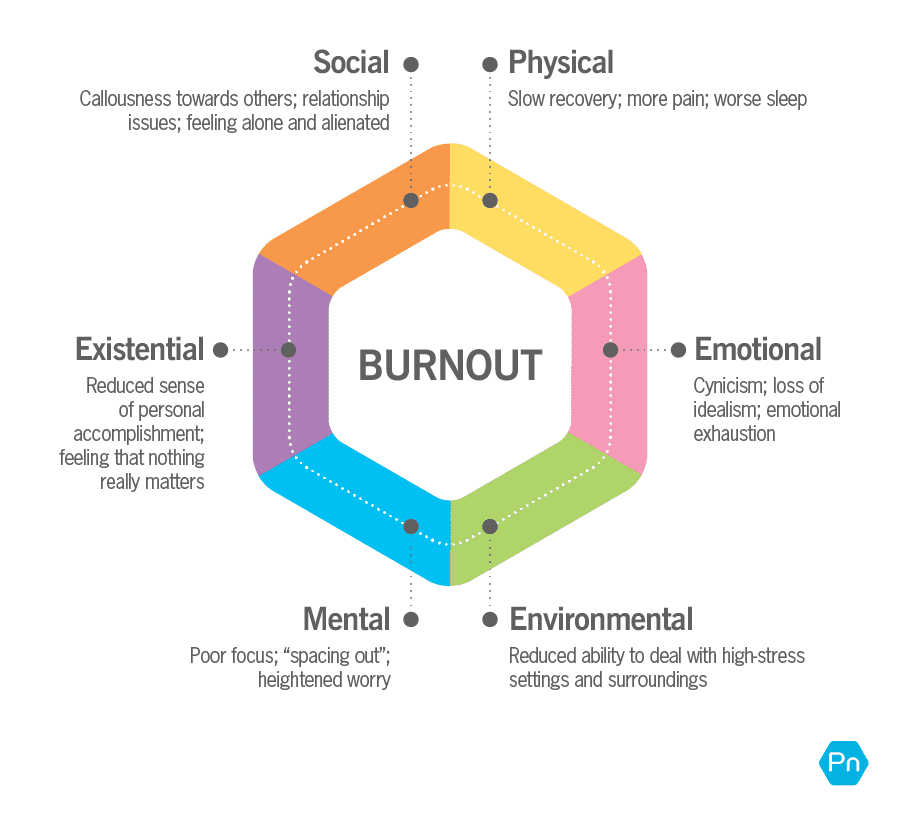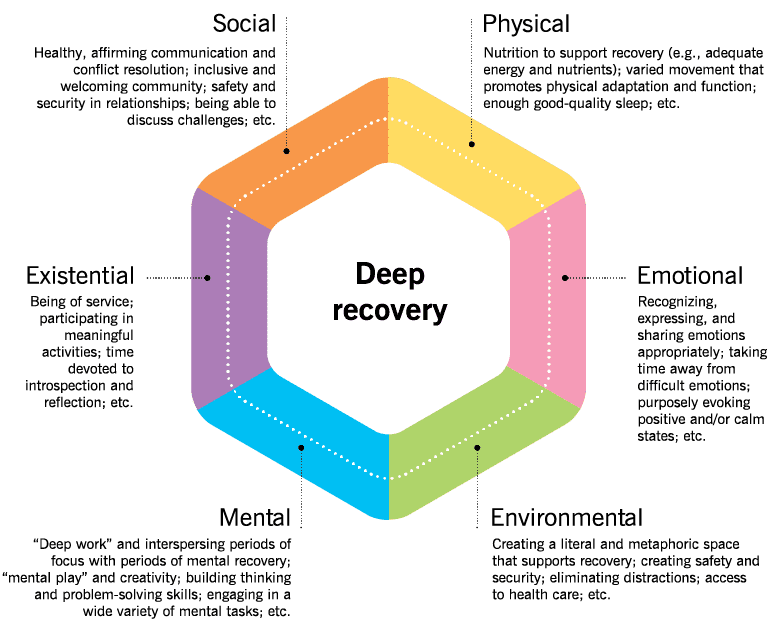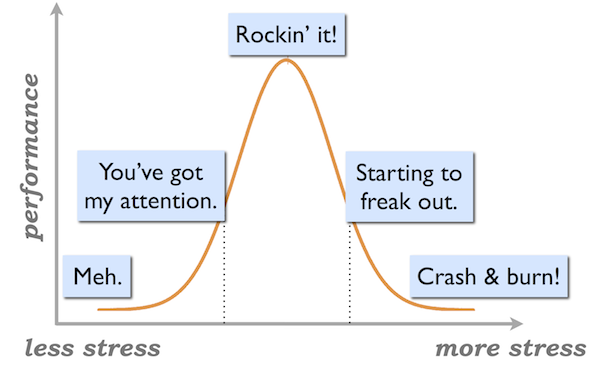“Is it burnout, or am I just being a baby?”
Burnout is gaining recognition in the work and wellness worlds. This makes sense, as self-reported stress levels are higher than ever.1 (And global pandemic, you’re really not helping.2)
But, like many health conditions, especially those related to mental health, there’s still a fair bit of stigma around burnout.
Some people hear the term “burnout” and say:
“This wasn’t a thing when I grew up. When did people become allergic to hard work?!” (As they take a big gulp of their mid-morning bourbon.)
Truth is, burnout is nothing new.
It’s been around as a clinical concept since the 1970s, and it surely existed before we slapped a formal name on it.3
But in 2019, the World Health Organization officially recognized it as a workplace phenomenon, and are currently working on developing tools to help recognize, treat, and most importantly, prevent burnout in workplaces.4
That’s good news because: Knowing you’re burned out also means you can recover from it sooner—and better.
Plus, preventing burnout usually means improving overall wellbeing.
In this article, we put together a handy quiz to help you spot the signs of burnout—either in yourself or in clients. (If you want to jump to it, click here.)
After that, we’ll share three ways to counteract burnout—even if you can’t make stress “go away.”
Ready? Let’s dig in.
++++
What is burnout?
Burnout, also known as burnout syndrome, is a state of mental, emotional, and physical exhaustion that can happen when the demands in our lives consistently and chronically outweigh what we’re able to do or produce.5,6,7
It’s not a single bad day—or even week—at work. Rather, it’s an ongoing, long standing pattern of feeling like you’re trying and failing, without success, support, recognition, or recovery.
In most countries, burnout isn’t considered a medical condition, but rather an occupational (workplace) phenomenon.
That said, some places (hi, Sweden and the Netherlands), do recognize burnout as a medical diagnosis that requires time off from work.
Folks most at risk for burnout have jobs where:
- Actual demands are high (fast-paced work, high stakes, lots of decisions, significant consequences for mistakes)
- Perceived demands are high (it feels rushed, overwhelming, urgent, and busy—especially for people who care about “doing a good job” or “being a team player”)
- Ideals are high (people have high personal standards and strongly believe in the value and importance of their work)
- Resources are low (such as time, money, support, and rest)
When you think of this combination, you might already be imagining who feels it most: service jobs like health care, first response, teaching, or coaching are prime examples of occupations with high rates of burnout.
But burnout can affect people in any career. And even though it stems from work, burnout’s shockwaves can impact all areas of your life.

Luckily, recovery can also come from many areas of your life. We’ll get to that part in just a minute.
Burnout quiz: Are you showing signs of burnout?
For each statement that sounds like something you experience relatively often, tick the box.
At the end of the quiz, you’ll get a score.
In general, the more signs you experience, the more likely you are to be on the road to burnout. (Check out the tips we offer at the end of this article.)
Important: This is not a clinical diagnostic test.
If you’re noticing more than a few of the below, even if it doesn’t feel like a “big deal,” consider consulting a healthcare professional.
Sleep, fatigue, and energy levels
- Trouble falling or staying asleep – 1 point
- Poor quality sleep (e.g., restless, wake up often) – 1 point
- Tired (so, so tired); run down and drained – 1 point
- Wired… can’t sleep! Running on an invisible hamster wheel! – 1 point
- Rely on caffeine for alertness through the day (e.g., coffee, black tea, energy drinks, caffeine tablets) – 1 point
- Body feels heavy or sluggish – 1 point
Physical symptoms
- Heart palpitations, racing heart – 1 point
- Tightness in chest or trouble breathing – 1 point
- Stomach upset, digestive issues (e.g., heartburn, gas, irritable bowel) – 1 point
- Headaches, migraines – 1 point
- Jaw pain/tightness; tooth grinding (dentist might notice this if you don’t) – 1 point
- Jumpy, startle easily – 1 point
- Chronic aches and pains (e.g., muscle aches, inflamed joints, back or neck pain) – 1 point
- Irregular, painful, and/or absent menstrual cycles (if you have a uterus and would typically be menstruating) – 1 point
- Feeling spaced-out or dizzy – 1 point
- Hunger and food cravings; emotional eating – 1 point
- Lack of appetite – 1 point
- Poor immunity—you seem to get every bug going around or just feel kind of “off” much of the time – 1 point
- Poor recovery—takes longer to recover from workouts, injuries don’t heal as well, seems hard to bounce back – 1 point
- Inflamed (e.g., flare-ups of allergies, skin issues, joint pain, sinusitis) – 1 point
- Hair falling out – 1 point
Cognitive / mental symptoms
- Forgetful or often worry about forgetting things – 1 point
- Hard to concentrate or focus – 1 point
- Feel anxious and/or worry a lot – 1 point
- Feel overwhelmed, and/or frazzled—so much to do/juggle! – 1 point
- Procrastinate and/or avoid tasks – 1 point
- Hard to prioritize tasks or choose what is important to do next – 1 point
One or more of these thoughts seem familiar:
- “Everyone else is the problem. They’re so unmotivated/stubborn/lazy/crazy.” – 1 point
- “My boss/workplace is the problem.” – 1 point
- “Everything around me is broken. Nothing works right. I hate ____.” – 1 point
- “This is all out of my control. So many things need to be fixed, but it’s not my job to do it.” – 1 point
- “I just keep trying and trying, but it’s like being on a hamster wheel. I never get anywhere.” – 1 point
- “I’m fine. This is fine. It’s all fine. I’ll just handle it like I always handle it. Fine. Fine. I’m totally fine.” – 1 point
- “AAAAAAAAAAAAAHHHHH!!!!” – 1 point
Emotional symptoms
- Feel “blank”, emotionless, numb – 1 point
- Feel sad or “down” – 1 point
- Feel trapped and stuck, out of options – 1 point
- Feel pessimistic, discouraged, hopeless, “what’s the point” – 1 point
- Feel resentful, irritable, short-tempered – 1 point
- Feel chronically frustrated; everything around you sucks and people are jerks – 1 point
- Feel disconnected, alienated, alone – 1 point
- Feel like nobody recognizes or appreciates you and/or your work – 1 point
- Feels like nothing you do or are is good enough – 1 point
- Seems like nearly every day is a hard day – 1 point
- Feels like you need something to cope (e.g., drugs, alcohol, eating/not eating, shopping) – 1 point
- Often focused on your shortcomings (e.g., not fit enough, not good enough, not smart enough, not organized enough) – 1 point
- Feel out of control – 1 point
- Trying very hard to control other things—like your body, other people, your routine—but it feels like you’re failing – 1 point
Relationship symptoms
- Can’t relate to or connect with other people, such as family, friends, coworkers, clients, etc. – 1 point
- Avoid others (e.g., procrastinate contacting clients, keep office door closed to other people, such as family, friends, coworkers, or clients) – 1 point
- Feel like you can’t depend on or trust other people (they screw things up or let you down) – 1 point
- Active conflicts with others at work, home, school, etc. – 1 point
Your burnout score:
Score: 3 or less
Sounds like you’re doing alright. You may have an occasional bad day, but you recover from it, and move on.
Score: 4 to 8
Hmm. You might benefit from a little more recovery and self-care. Consider consulting a qualified mental health professional, even just for a chat.
Score: 9 to 13
Be careful—you’re at risk of burnout, particularly if you feel several of these intensely and often. Consider consulting a qualified mental health professional.
Score: 14 to 18
You are at severe risk of burnout. Do something about this urgently. Seek help and support from a qualified professional.
Score: 19 or more
You are at very severe risk of burnout. It’s time to take action and seek help and support from a qualified professional.
3 ways to counteract burnout syndrome
Whether you scored high and are looking for a solution, or you’re curious what to do if you’re concerned about burnout creeping up on you in the future, here’s what can help.
(And if you’re working with a client showing burnout symptoms, you’ll definitely want to share these strategies with them.)
#1: Protect your time, space, and emotional investment with good boundaries.
Boundaries, or the lack of them, are a key factor in burnout.8
This can be boundaries between:
- Home and work (for instance, struggling when working remotely, finding yourself doing work outside of work hours… or in your bed)
- Personal and professional identities (accidentally venting about personal stuff to a client, or being asked to do work that’s outside the scope of your job)
Conversely, having clear, strong, and well-defined boundaries can alleviate burnout by:
- Helping you switch “work mode” on and off.
- Protecting time with friends and loved ones.
- Reducing the amount of emotional labor you’re doing.
(Emotional labor means managing other people’s feelings, as well as controlling your own emotional response to them. Learn more: Invisible stressors: Are they sucking the life out of your health?)
How do you maintain good boundaries? Here are a few ideas.
▶ Identify what you can and can’t control. Try our Sphere of Control Worksheet.
▶ Implement a “focus filter.” Consciously tell yourself, ‘I’m choosing to focus on THIS right now.’ This applies to work—you don’t do housework or counsel your mother-in-law while you’re trying to do your job—but it can also look like spending time with your partner without thinking about work as you gaze across a candlelit table.
▶ Be intentional about your environment. If remote working muddles your work-life boundaries, set up a separate space for work-related duties—even if it’s a specific corner of your kitchen table or the middle seat of your couch.
Because as fun as it is to take conference calls from bed in your housecoat, creating separation between “work” and “home” will make turning off “work mode” and getting into “rest mode” at the end of the day feel much easier.
(Plus, if you can go somewhere and shut a door, it might—slightly—reduce your “on-call” status for other family members. Cue: “MOM!! Billy is touching my Tonka truck with his Lego!!”)
▶ Clarify your boundaries—what you’re saying “yes” and “no” to at a given time. Maybe you tell yourself you want to say “yes” to family time (or plain old sanity time for yourself), so you’re no longer checking emails after 6 pm.
You could uphold that boundary by putting your phone on mute, so you don’t hear emails pinging as they come in.
▶ Communicate your boundaries clearly to others, and enforce them as needed. Tell others what your boundaries are. Be explicit and clear. Don’t expect folks to “just know.” (As Brené Brown says, “clear is kind.”)
It can be uncomfortable to advocate for your needs, but it’s kinder to yourself—and the other person—to be honest about what you can and can’t sustain. In our work email situation, that might mean putting on an auto-responder that lists your office hours, so people know when to expect to hear back from you.
▶ Remember, it’s not just about the “no.” It’s also about the “yes.” As in, what have you consciously decided is worth your time, energy, and attention?
What activities are aligned with your values? What do you want to do and feel more of? What needs to be cleared, constrained, or revised so that you can prioritize better, and “replenish your tank” more effectively?
#2: Cultivate engagement by spending more time on what you love doing, with people you love working with.
The flip side of burnout is engagement.9,10
Engagement means you’re thriving in your work role. You’re energized by your work, and the people around you support you and respect your boundaries.
Rates of burnout are lower in workplaces that focus on the following six engagement-promoting components:11
- Appropriate workloads
- Control over work (at least a little)
- Rewards, including simple appreciation and recognition
- Community and genuine, supportive social connections
- Fairness and equity
- Values that feel meaningful
Of course, if you’re an employee, you may not have control over whether or not your job has all these components. But you can:
▶ Talk to your manager about workload, what you want to work on, and how you’d like to receive feedback. Rather than trying to do all the things like a hero, ask for help prioritizing, if needed.
▶ Build strong connections. Invest time in relationships that feel genuine and supportive. If possible, connect with colleagues… and also have relationships that have nothing to do with work.
▶ Consider your values. What matters to you? Think about what your personal values are, and how they align with the work you’re doing. Have your values changed? Or do you just need more help finding a match between job demands and what you truly feel is important?
▶ Model productive, collegial, and growth-oriented behavior. Many teams bond over a shared hatred of workloads, clients, bosses, or the general day-to-day BS.12
In some ways, this is practical and realistic. However, research suggests that only venting—without productive and positive action—doesn’t make us feel better.13,14
In fact, focusing all our attention on awfulness tends to make us feel worse. So, if your coworker had a crap day, instead of complaining about how horrible the job is, buy them a coffee or suggest you both sneak out for a walk in the park.
▶ Consider constraining the complaints. Some psychologists suggest using a “complaint window” during which you specifically allot time and energy to complaining. Outside of that time, you don’t.
For instance, “I’m going to devote the next ten minutes to saying all the things I hate about work, then that’s it for the day.” (The same principle works for a “worry window”—establishing a set period of time to worry about things.)
▶ Practice compassion. Sure, some customers might just suck, and some bosses are just grouchy tyrants. But many people are under pressure themselves, or struggling with stress they don’t know how to manage.
Unless it’s clear you work with a sadistic sociopath, try to find the human underneath, and consider what they might be going through. If you can’t find compassion, that can be a sign of compassion fatigue. Try our Compassionate Coaching Worksheet.
If you don’t have a boss or manager (maybe you’re a self-employed coach or you’re a caregiver to a family member), consider how you might implement these ideas into your work situation.
That might mean delegating or outsourcing tasks to manage your workload, saying no to things you really don’t want or have time to do, or finding a mentor to provide advice and social connection. (A mentor can skyrocket your potential. See: How to find a mentor, and why mentorship is so important for you—and your clients.)
#3: Focus on deep recovery.
There are going to be times when you can’t lower your demands.
What happens then?
Increasing recovery can help offset increased stress.
By pumping up your recovery practices, you may find you’re better able to handle workplace (and everyday life) stress.
Recovery isn’t just sleep and taking days off from the gym. The best kind of recovery addresses multiple aspects of your health—your physical health, yes, but also your emotional health, your social health, and more.
We call this “deep recovery.”

With burnout, the mental, emotional, and existential pieces are particularly important. However, many people might experience these as physical issues too. For instance, you might not consciously feel angry… but your jaw muscles are grinding like a wood chipper. You might not consciously feel hopeless… you just feel exhausted.
Having a professional as an ally to work through those areas—especially one you like who you feel understands you—can help you get better results and feel less alone.
Consider reaching out to your primary care physician or a therapist (or encouraging clients struggling to do so).
And remember:
Asking for help is a sign of strength, not weakness. (Even The Rock needs a spotter when he benches 900 pounds.)
References
Click here to view the information sources referenced in this article.
If you’re a health and fitness coach…
Learning how to help clients manage stress, build resilience, and optimize sleep and recovery can be deeply transformative—for both of you.
It helps clients get “unstuck” and makes everything else easier—whether they want to eat better, move more, lose weight, or reclaim their health.
And for coaches: It gives you a rarified skill that will set you apart as an elite change maker.
The brand-new PN Level 1 Sleep, Stress Management, and Recovery Coaching Certification will show you how.
Want to know more?




Share